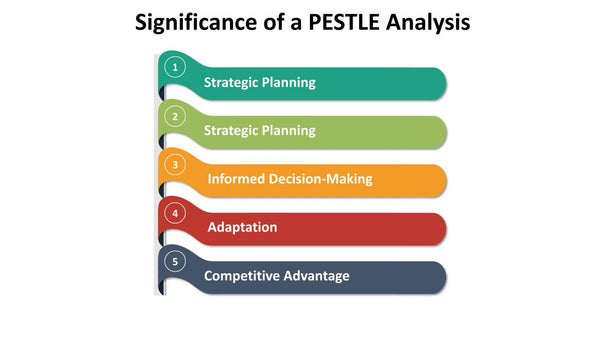Exploring PESTLE Analysis Template: A Strategic Planning Tool
In today's rapidly changing business environment, staying ahead of the curve and making informed decisions is essential for organizations of all sizes and industries. One valuable tool for strategic planning and decision-making is the PESTLE analysis. This comprehensive guide will provide you with a thorough understanding of what a PESTLE analysis is, its significance, and a detailed template to help you conduct a PESTLE analysis effectively.
What is a PESTLE Analysis?
A PESTLE analysis is a strategic framework used to analyze and evaluate the external macro-environmental factors that can impact an organization's operations and decision-making. The acronym PESTLE stands for Political, Economic, Social, Technological, Legal, and Environmental factors. By examining these six key aspects of the external environment, organizations can gain insights into potential opportunities and threats, enabling them to make more informed strategic decisions.

The Significance of a PESTLE Analysis
A well-executed PESTLE analysis provides several key benefits for organizations:
- Risk Mitigation: Identifying external factors that could impact the organization helps in proactively mitigating risks and avoiding potential crises.
- Strategic Planning: PESTLE analysis informs strategic planning by highlighting opportunities for growth and expansion and potential barriers to entry.
- Informed Decision-Making: Decision-makers can make more informed choices about resource allocation, market-entry, and product development based on the analysis.
- Adaptation: It enables organizations to adapt to changing circumstances and anticipate shifts in the business landscape.
- Competitive Advantage: By staying ahead of external trends and factors, organizations can gain a competitive advantage in their industry.
Now, let's delve into the detailed template for conducting a PESTLE analysis:
PESTLE Analysis Template
Please note that this template is a guideline, and the depth of analysis may vary depending on the specific needs and context of your organization.
1. Political Factors
Political factors encompass the influence of government policies, regulations, and political stability on your organization. Analyze how these factors may impact your business by considering the following questions:
- What government policies and regulations affect our industry?
- Are there any political stability issues in our target markets?
- How might changes in political leadership or government priorities impact us?
- Are there any trade restrictions or tariffs that could affect our operations?
2. Economic Factors
Economic factors relate to the economic conditions and trends that can influence your organization's financial performance. Assess the economic factors by considering:
- What is the current state of the economy in our operating regions?
- How might inflation, interest rates, or exchange rates affect our costs and pricing?
- Are there any economic cycles or trends that could impact consumer spending?
- What is the level of disposable income among our target market?
3. Social Factors
Social factors encompass the demographic, cultural, and societal aspects that can affect your organization's customer base and reputation. Explore social factors through these questions:
- What are the demographic trends in our target market?
- How do cultural norms and values influence consumer behavior?
- Are there any emerging social trends, such as sustainability or health consciousness, that we should consider?
- What is the level of education and technology adoption among our customers?
4. Technological Factors
Technological factors pertain to advancements and innovations that can impact your operations and competitiveness. Evaluate technological factors with these considerations:
- What technological trends are relevant to our industry?
- How does technology impact our production processes, distribution, and communication with customers?
- Are there any potential disruptive technologies that could reshape our industry?
- How is our organization leveraging technology for competitive advantage?
5. Legal Factors
Legal factors involve the laws, regulations, and legal considerations that affect your organization's operations and compliance. Analyze these factors by asking:
- What are the key regulations governing our industry?
- Are there any pending or potential changes in legislation that could impact us?
- How do intellectual property rights and contracts affect our business?
- Are there legal risks, such as liability or litigation, that we need to address?
6. Environmental Factors
Environmental factors encompass sustainability, ecological concerns, and the impact of climate change on your organization. Assess these factors by considering:
- What environmental regulations and standards apply to our industry?
- How does our organization address sustainability and environmental responsibility?
- Are there climate-related risks, such as extreme weather events, that could affect our operations?
- How do consumer attitudes toward environmental issues influence our products or services?
Analysis and Action Plan
Once you've gathered information on each of the six PESTLE factors, it's essential to analyze their significance and prioritize them based on their potential impact and urgency. Consider the following steps:
- Rate each factor on a scale (e.g., low, medium, high) based on its relevance and potential impact.
- Identify the most critical factors that require immediate attention.
- Develop a strategic action plan for addressing or capitalizing on these factors.
- Assign responsibilities, set timelines, and allocate resources for implementing the action plan.
- Continuously monitor and update your PESTLE analysis as external factors evolve.
Conclusion
A PESTLE analysis is a valuable tool for organizations seeking to make informed strategic decisions in a dynamic and ever-changing business environment. By systematically examining political, economic, social, technological, legal, and environmental factors, organizations can identify opportunities and threats, mitigate risks, and adapt to emerging trends. Utilize the provided template as a guide to conduct a comprehensive PESTLE analysis tailored to your organization's needs and leverage the insights gained to drive strategic success and sustainable growth.

